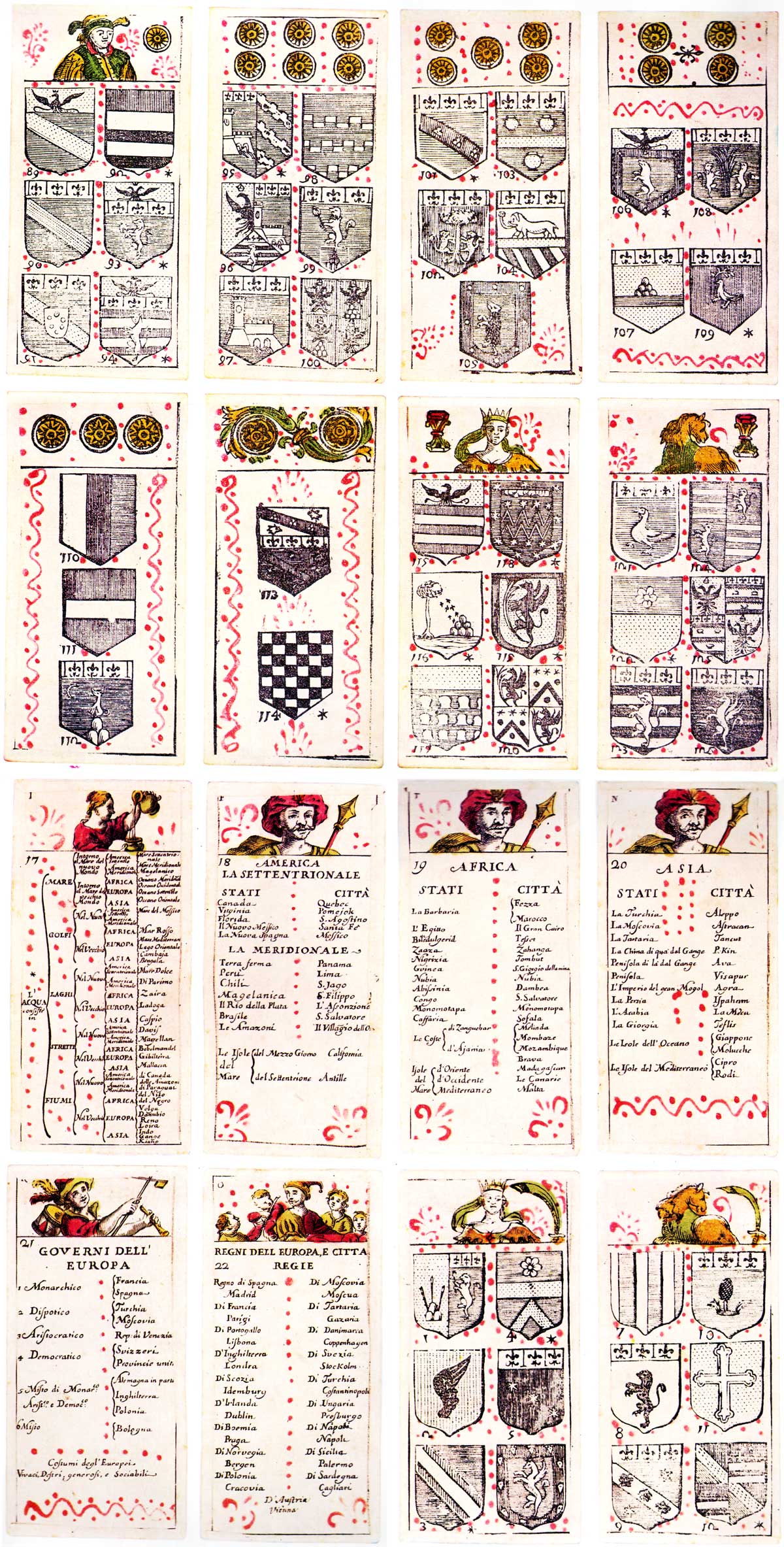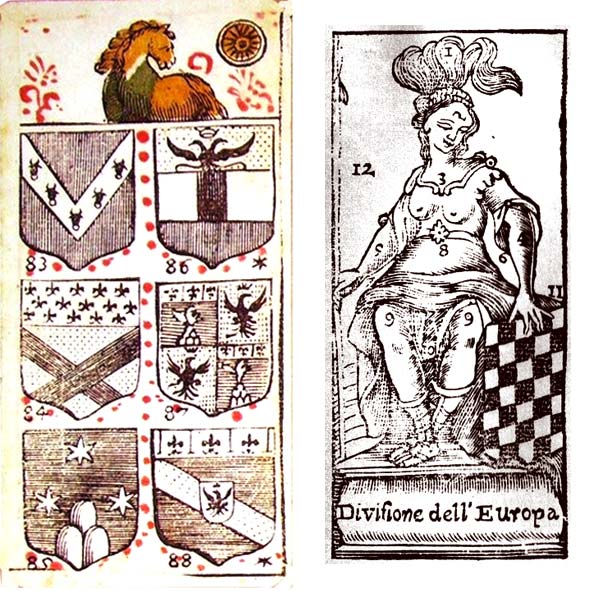L’Utile col Diletto
Geographical and Heraldic Tarocchi cards from Bologna, 1725.
“L’Utile col Diletto, ossia geografia intrecciata nel giuoco de Tarocchi”
Geographical and Heraldic Tarocchi cards, Bologna, 1725

A flood of educational cards appeared during the seventeenth and eighteenth centuries, mostly geographical or heraldic, although the trend had begun even earlier. An interesting tarot deck was produced in 1725 by Rev. Luigi Montieri as an educational game in order to teach geography, heraldry and European politics. The Trump cards contain geographical data and the numeral cards armorial shields of who was important at the time. Every card has a stencil-coloured image or suit symbol in the top quarter of the card so that it can be used as a pack of cards. It so happened that Trump No.21 (Il Matto) describes the government of Bologna as ‘mixed’, although technically at that time Bologna was part of the Papal States. This annoyed the papal legate, Cardinal Ruffo, who arrested the priest and all the staff involved in the publication. An edict followed banning the deck and ordering seizure of all copies which were burned.


Above & left: “L’Utile col Diletto, ossia geografia intrecciata nel giuoco de Tarocchi”, a set of 62 Geographical and Heraldic Tarocchi cards created by Luigi Montieri and published in Bologna, 1725. The reverse shows an allegorical figure titled “Divisions of Europe”. The accompanying booklet titled “L'utile col diletto, ossia geografia intrecciata nel Gioco dei Tarocchi, con le insegne degli Illustrissimi ed Eccelsi Signori Gonfalonieri ed Anziani di Bologna dal 1670 al 1725” gives a key to the heraldic attributions and divisions of Europe which are illustrated on the cards. The Trump cards contain the geographical tables and the minor cards the armorial shields. The former are etchings, the latter woodcuts. Every card has its symbol or suit-mark at the top. This is of course a non-standard version of the tarocchino of Bologna; originally the 2, 3, 4 and 5 of the numeral cards were omitted, but in the present sequence the 7, 8, 9 and 10 of each suit are omitted, probably to save space in the top parts of the cards.
This elaborate production involved preliminary research and then organising woodcuts, etchings, stencil colouring, turned-over backs and a separate explanatory booklet. These turned-over backs sometimes obscured parts of the image on the front but produced a very sturdy card. In particular the small capital letters on the 22 trumps are sometimes obscured, which when arranged in descending order, with the Fool at the bottom, form the words: LOUIS C MONTIERI INVENTOR.

The deck was suppressed soon after publication by order of the Pope on account of being considered vain and improper, and for describing the government of Bologna as ‘mixed’. An edict followed ordering seizure of all copies which were burned. Rev. Luigi Montieri and the staff involved in the publication were arrested. However, the scandal was petty and might have aroused resentment in a city proud of its ancient liberties. Following some diplomatic efforts the case was dropped and three days later all those arrested were released, but the ban remained in place so it was not possible to print more copies. An original copy survives in the Museum of the city of Bologna. Cards illustrated from the facsimile edition by Edizioni del Solleone, 1973.
REFERENCES
Arienti, Vito: Il Solleone, dieci anni di azioni promozionali, editoriali, provocatorie di amicizia, di collezionismo nel mondo Europeo della cartagiocofilia 1969-1978, Edizioni del Solleone, Lissone (Milano) 1978.
Accademia del Tarocchino Bolognese→
Tarot History discussion on facebook→ (scroll down to May 22, 2014, post by Enrique Enriquez)

By Simon Wintle
Member since February 01, 1996
I am the founder of The World of Playing Cards (est. 1996), a website dedicated to the history, artistry and cultural significance of playing cards and tarot. Over the years I have researched various areas of the subject, acquired and traded collections and contributed as a committee member of the IPCS and graphics editor of The Playing-Card journal. Having lived in Chile, England, Wales, and now Spain, these experiences have shaped my work and passion for playing cards. Amongst my achievements is producing a limited-edition replica of a 17th-century English pack using woodblocks and stencils—a labour of love. Today, the World of Playing Cards is a global collaborative project, with my son Adam serving as the technical driving force behind its development. His innovative efforts have helped shape the site into the thriving hub it is today. You are warmly invited to become a contributor and share your enthusiasm.
Related Articles

Late flowering of the Lyon pattern
Faustino Solesio’s late version of the Lyon pattern from about 1870.

Historic Shakespeare
“Historic Shakespeare” playing cards featuring Shakespearean characters by Chas Goodall & Son.

Czech National Patterns by S.D. Modiano
Modiano produced cards with the Prague and Trappola patterns in the early 20th century.

Emilio Tadini playing cards
Beautiful dreamlike playing card designs by Emilio Tadini.

German Travel Cards
A travel-themed educational deck helping American tourists visiting Germany.

Can You Believe Your Eyes?
“Can You Believe Your Eyes?” playing cards featuring visual illusions & other oddities.

Austrian Tarock by S.D. Modiano
Modiano’s Austrian Tarock with country scenes has been in production for over 100 years.

Le carte da gioco Arcimboldo
Courts and suit-signs inspired by the works of the Italian Renaissance painter, Giuseppe Arcimboldo....

22 Pittori in 22 Arcani
Collaborative Tarot with contributions from 22 different Italian artists including Menegazzi and Tav...

Baraja de Juan Martín Zamorano
Deck inspired by El Pendón de los Zamorano, a military pennant dating from 1501, published by Priego...

Justice playing cards
Ethical concepts in a deck produced by Riccardo Conturbia’s Passione Playing Cards Ltd.

Alan Tarot Deck
Reprint of a Tarock pack originally designed by Argio Orell for the Austrian Lloyd shipping company....

Il Tarocco del Mondo Nuovo
Imaginative Tarot card designs by Amerigo Folchi relating to Columbus and the New World.

22 Artisti Liguri in 22 Arcani
Collaborative set of major arcana devoted to Christopher Columbus and his voyages of discovery.

Carte di Colombo
Fully illustrated pack designed by Pier Canosa commemorating the 500th anniversary of the discovery ...

Carte di Natale
Designed by Pier Canosa as a Christmas pack for the Cortina Art Gallery in Milan.
Most Popular
Our top articles from the past 28 days

